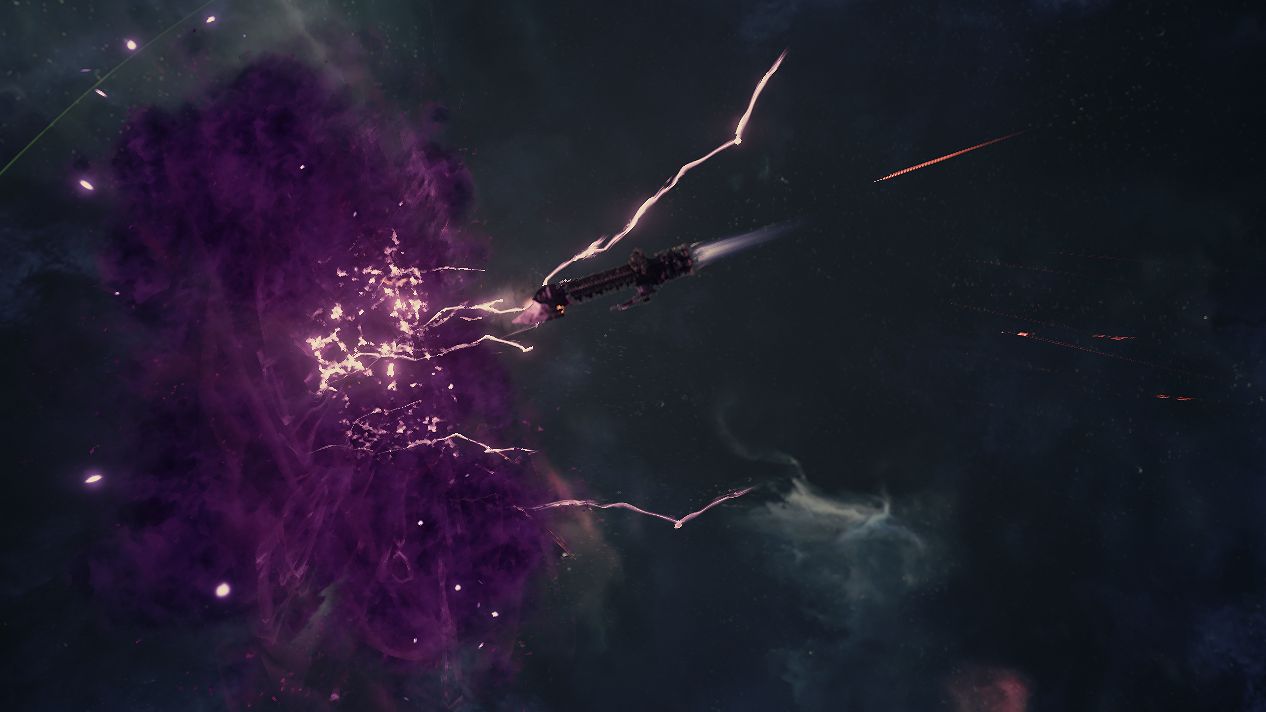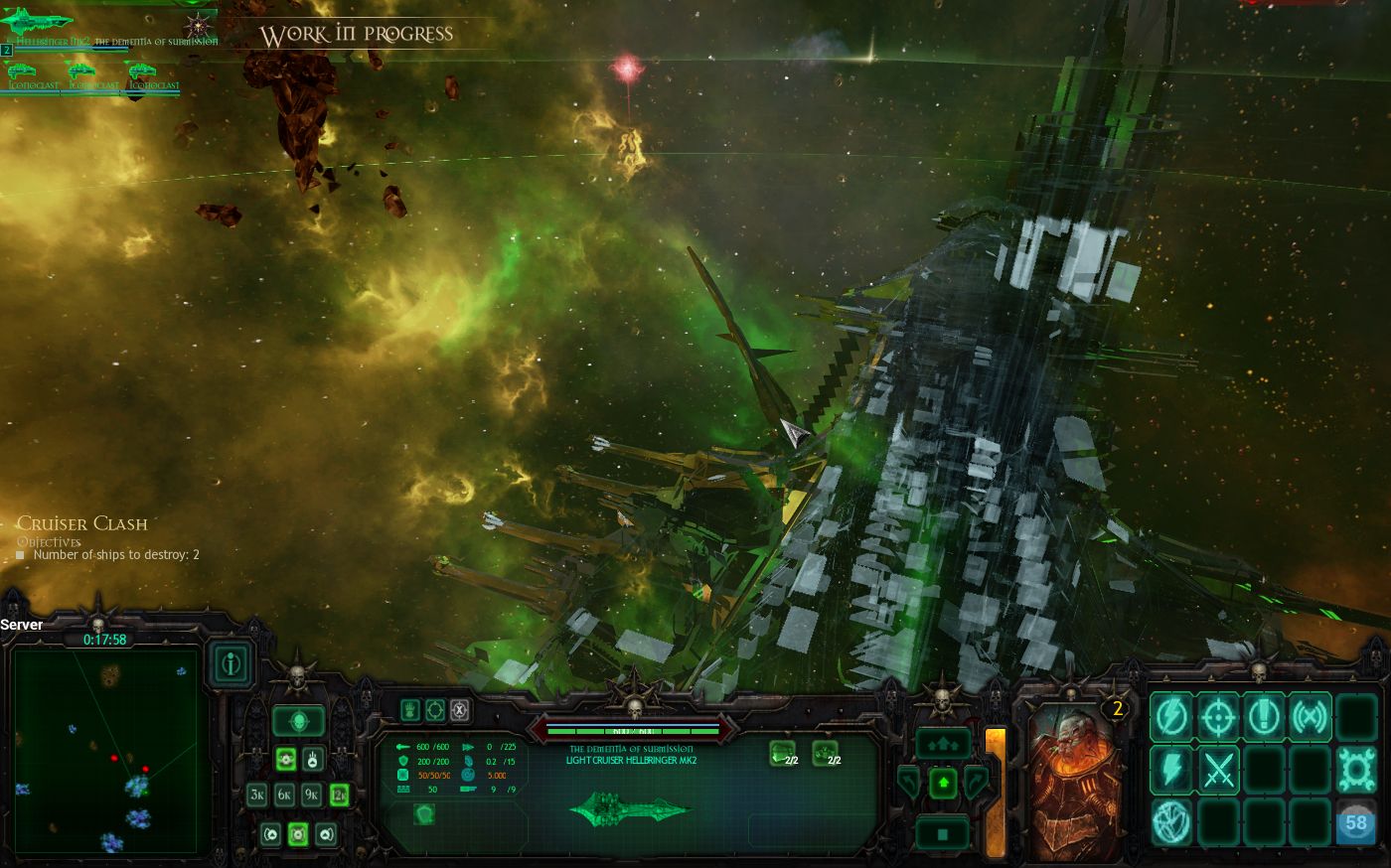Blasting gunboats with nova cannons in Battlefleet Gothic: Armada

From way up here, looking down on the space battle, I can’t see much detail on my twenty-kilometre flagship; I can’t see guns firing, or the bombers taking off, or the damned souls demons presumably writhing across its demon-possessed surface, or the slaves being squished in its grimdark interior. I can however see the desperate spinning up of the warp drive in the moments before the ship explodes like a Hollywood chicken coop.
I accept that I’m not very good at Battlefleet Gothic: Armada. I managed to lose the second tutorial mission (against the Space Orks) pretty comprehensively, and I’ve not managed to win a single multiplayer battle. Apologising into the chat as another one of my escort ships wanders distracted into a planet-sized minefield wasn’t unusual. (The other player reassures me it’s okay, he’s done it too, before laying waste to my minions.)
For those unfamiliar with the Warhammer 40K universe, it’s the far future where a human galactic empire is besieged by rebels and aliens. The Imperium and Chaos were playable in this beta. The Imperials are space-Fascists who fly slow but heavily-armoured, heavily-armed craft, some with the mighty Nova Cannon. Chaos are faster, better at long range, and riddled with monsters from beyond human ken.
In the main campaign you play as the Imperium defending against a massive Chaos invasion, fighting over a large array of star systems. Here though, the beta included two campaign missions to act as a tutorial for the multiplayer and skirmish modes. For the purposes of testing, the game was limited to 1v1, though the final game will have 2v2 modes.
The multiplayer missions I played were small—one or two large ships of the line and their smaller escorts on each side. The ships of the line level up through successful missions, gaining abilities, perks, and favours, but if they’re put out of commission you have to wait two battles to use them again. The escorts are completely disposable, but even a group of them would have trouble taking down a ship of the line.
As is normal at this stage, the balance is still way off—this game probably needs a good wodge of beta testing before release. Particularly, the Imperium’s super long-ranged, area-of-effect Nova Cannon has been drawing flak for being overpowered—which is hard to argue against, as it’s overpowered in the fiction too. It makes torpedoes, which should be taking that long-distance role, seem weak and ineffectual.

Other elements need tweaking. Ships of the line seem to cost the same to bring into battle, no matter how high level and upgraded they are, which is enormously unfair. At low rank levels, the Chaos fleet seems weak and expensive compared to the Imperium fleet, which could do with a nerf.
Keep up to date with the most important stories and the best deals, as picked by the PC Gamer team.
That said, the look of the game is right. The spacecraft are delightfully-modelled and intricately detailed, and really quite attractive. The only flaw at this level is that there’s no real sense of scale in battle—except for certain cutscenes, these could as well be miniatures as they could intergalactic war machines the size of Tokyo.
The battlefield could use more detail. While it’s true to the tabletop game, it’s not particularly interesting, with its its 2D plane and gas clouds decor—the poor Sid Meier’s Starships had more interesting map features. Even the persistent wrecks of ships during the battle seem rarely relevant. By the time a ship blows up, the battle is mostly lost. (And the captain should have warped out before then.).
It’s micro-heavy. Each ship needs careful management at all times.
But that’s made up for by the improved complexity of the combat. When I saw this demoed, I was worried that there wasn’t much to do. Playing it, it’s micro-heavy. Each ship needs careful management at all times. The array of actions, even with the small fleets you start with, requires you to use your Tactical Cogitator—that is, a depleting pause-time meter—to plan your moves more carefully.
Notably, like the galleons the fiction is based on, the larger a ship is, the slower it turns. Some ships, like the Orks’, have large turning circles, whilst the fragile Eldar are fast and agile. An additional manoeuvres meter is used for Full Steam Ahead charges and high-speed turns—highly useful for dodging torpedoes, rams, or the three types of slow-cast bomb upgraded ships can access.
You also can’t win games without using the attack focus buttons, used to prioritise targets and to destroy subsystems such as the engines or turrets. And, of course, your ships of the line have special powers to micromanage, including boarding parties, stasis bombs, and an array of timer-driven activated buffs like focused fire, silent running or repel boarders. It all works well, and you’re certainly busy at every stage of a battle.

Once you’ve won or lost a battle, you get renown for how well you did, which you can use to level up your ships of the line. At this stage, the metagame is a little broken because losing a ship is punishing; there’s a bigger incentive to keep your ships intact and flee, meaning players warp their ships out rather than finish fights. That said, battles are over quickly anyway.
Tindalos’ earlier games, Stellar Impact and Etherium, both have unresolved bugs and an army of disgruntled players pushing down their Steam user ratings. I asked Roman Clavier, the game director, about how they were going to reassure players that BG:A wasn’t going to get the same treatment.
“We’ve put a great deal of attention during the development of Battlefleet Gothic: Armada.” he told us. “We have conducted several alphas, invited players to play tests, run as many stress tests as possible and even invited influencers from the community to give us their educated opinion. In a word, we put the game stability as a top priority on Battlefleet Gothic: Armada and a lot of effort in having a clean and polished game.”
“The MP Beta accessible for all the players who pre-ordered the game will give us a very last opportunity to bring a top-note of balancing and optimization. A dedicated team of people will also make sure the release of the game is as smooth as possible and that players can fully enjoy the game.”
At the moment, in my experience, the speed and reliability of matchmaking is praiseworthy. Barring one crash bug, I joined every game quickly and smoothly, and didn’t suffer any lag or in-battle errors. It was possible to play several games within an hour, without a hitch.
Battlefleet Gothic’s multiplayer is looking solid, but is in need of balancing for the two factions playable so far. With the much more asymmetric Orks and Eldar to come, I’d say work needs doing—and as it’s out this month, if you’re buying it for the multiplayer, you might want to wait until it settles down.

